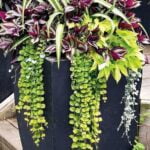African iris landscape ideas are a great way to enhance the beauty of your outdoor space. The African iris, also known as Dietes vegeta, is a stunning and versatile plant that can add elegance and charm to any landscape design. In this article, we will explore the various ways in which African iris can be used to create a beautiful and thriving outdoor environment.
Understanding the characteristics and growing requirements of African iris is essential for creating a successful landscape design. From planting and maintenance tips to utilizing it for water-wise landscapes, attracting wildlife, and designing colorful gardens, there are numerous creative ideas for incorporating African iris into your outdoor space.
Whether you’re looking to use African iris as ground covers, borders, or as part of a water-wise landscape design, there are endless possibilities for creating a captivating outdoor environment. This article will also feature case studies of successful African iris landscapes from around the world, offering inspiration and practical insights for incorporating this stunning plant into your own landscape design.
Understanding African Iris
The African iris, also known as Dietes vegeta, is a stunning and versatile plant that can add beauty to any landscape. Understanding the characteristics and growing requirements of African iris is key to incorporating this plant successfully into your garden design.
Characteristics
African iris is a perennial plant that belongs to the Iridaceae family. It features long, sword-like leaves and striking white flowers with yellow and blue accents. This plant is known for its ability to thrive in hot and dry conditions, making it an excellent choice for landscapes in arid regions.
Growing Requirements
African iris thrives in well-drained soil and prefers full sun to partial shade. This plant is relatively low-maintenance once established, but it does require regular watering during its initial growth period. Additionally, African iris is tolerant of a wide range of soil types, which makes it suitable for various landscaping environments.
Propagation
African iris can be propagated by division or from seedlings. When dividing existing plants, it’s important to ensure that each new division has a healthy root system attached. Seedlings can be collected from the plant’s seed pods and planted in individual pots until they are strong enough to be transplanted into the landscape.
Incorporating African iris into your landscape design can enhance the overall aesthetic while providing numerous benefits for local wildlife and the environment. With a thorough understanding of its characteristics and growing requirements, you can confidently introduce these beautiful plants into your outdoor space.
African Iris Planting and Maintenance
The African iris is a stunning and versatile plant that can add beauty and interest to any landscape design. When it comes to planting and maintaining African iris, there are a few essential tips to keep in mind to ensure a thriving and beautiful landscape.
First and foremost, it’s important to choose the right location for planting African iris. These plants thrive in full sun to partial shade, so be sure to select an area in your landscape that receives adequate sunlight throughout the day. Additionally, African iris prefers well-drained soil, so be sure to amend the soil with organic matter if necessary to improve drainage.
When it comes to watering, African iris is relatively drought-tolerant once established. However, during the initial establishment period, be sure to water regularly to help the plants develop strong roots. Once established, water the plants deeply but infrequently to encourage deep root growth and overall plant health.
In terms of maintenance, African iris is relatively low-maintenance once established. However, regular deadheading of spent blooms can help promote continuous flowering and tidy up the overall appearance of the plants. Additionally, dividing clumps every few years can help rejuvenate older plants and prevent overcrowding. By following these tips for planting and maintenance, you can ensure a thriving landscape filled with beautiful African iris.
By incorporating these tips into your landscaping efforts, you’ll surely achieve a successful display of color and texture while also attracting wildlife such as butterflies, bees, and birds to your garden or outdoor space. Working with various species of African Iris will also enable you to create unique patterns and designs that perfectly complement one another throughout different sections or areas inside your garden or outdoor layout plan.
The Versatility of African Iris in Landscape Design
African iris plants are a versatile addition to any landscape design, known for their hardiness, low maintenance, and beautiful blooms. These plants can be used in a variety of ways, from serving as ground covers to defining borders within a garden or yard. Their ability to thrive in various conditions makes them an excellent choice for both novice and experienced gardeners.
When using African iris as ground covers, it’s important to consider their growing requirements. These plants prefer well-drained soil and full sun but can also tolerate partial shade. Once established, they are drought-tolerant and require minimal water, making them an ideal choice for areas with limited irrigation. Planting African iris as ground covers not only adds visual interest but also helps with weed suppression, erosion control, and soil stabilization.
In addition to their use as ground covers, African iris plants make excellent border plants. Their upright growth habit and attractive foliage create a neat and tidy edge along walkways, flower beds, or property boundaries. When planning the layout of your landscape design, consider incorporating African iris along the edges of garden beds or around outdoor living spaces to add structure and definition to the overall design.
| Use | Growing Requirements |
|---|---|
| Ground Covers | Well-drained soil, full sun to partial shade, drought-tolerant |
| Border Plants | Upright growth habit, attractive foliage for structure and definition |
Creative Ideas for Incorporating African Iris in Water-Wise Landscapes
Water-wise landscapes are becoming increasingly popular as people strive to conserve water and create sustainable outdoor spaces. African iris is a fantastic plant choice for water-wise landscaping due to its drought tolerance and minimal watering requirements. This section will explore creative ideas for incorporating African iris into water-wise landscapes, from xeriscapes to desert gardens.
Xeriscapes and African Iris
Xeriscaping is a landscaping approach that focuses on reducing or eliminating the need for irrigation. African iris fits perfectly into this concept, with its ability to thrive in dry conditions once established. In xeriscapes, African iris can be used as a low-maintenance ground cover or accent plant, adding pops of color and texture without the need for excessive watering.
Desert Gardens and African Iris
In desert and arid climates, creating a garden that showcases the unique beauty of African iris can bring life and vibrancy to the landscape. Pairing African iris with other drought-tolerant plants such as succulents, agave, or yucca can create a stunning desert garden that requires minimal water upkeep. The bold foliage and striking flowers of African iris can provide an eye-catching focal point in a desert landscape while also attracting native wildlife.
Rainwater Harvesting With African Iris
For those looking to maximize their water conservation efforts, incorporating African iris into a landscape designed for rainwater harvesting is an excellent idea. The hardy nature of the plant means it can survive on harvested rainwater alone, reducing the need for supplemental irrigation. By strategically planting African irises in areas where rainwater naturally collects or using them in bioswales, homeowners can take advantage of this natural water source while enjoying the beauty of these resilient plants.
By thinking creatively and strategically, homeowners and landscapers can incorporate African iris into various types of water-wise landscapes, providing both beauty and sustainability to outdoor spaces.
Using African Iris to Attract Wildlife
African Iris, also known as Fortnight Lily or Morea Iris, is not just a beautiful addition to any landscape – it can also attract a variety of wildlife, such as butterflies, bees, and birds. These creatures are not only delightful to watch but also play an essential role in the ecosystem. By incorporating African Iris into your landscape design, you can create a haven for these charming visitors while adding another layer of beauty to your outdoor space.
Here are some ideas on how to use African Iris to attract wildlife to your garden:
- Plant a variety of African Iris species and colors to create an attractive display that will catch the eye of passing butterflies.
- Include other nectar-rich flowering plants alongside your African Iris to provide food sources for bees and butterflies. Consider plants like salvia, coneflowers, and lantana.
- Create a bird-friendly environment by planting African Iris in clusters or patches to provide cover and nesting spaces for small birds. You can also incorporate bird feeders and birdbaths nearby to attract even more feathered friends.
By using African Iris in strategic ways within your landscaping, you can help support local pollinators and wildlife while adding visual interest and a sense of life to your outdoor space. Remember that mindful planting choices that cater to the needs of wildlife can transform your garden into a thriving ecosystem.
Additionally, consider creating areas within your landscape specifically dedicated to attracting and sustaining wildlife with features like native plant gardens or pollinator-friendly zones. Incorporating African Iris into these spaces will not only enhance the environment but also offer you endless opportunities for observation and enjoyment.
Designing a Colorful African Iris Garden
African iris plants come in a variety of colors and varieties, making them an excellent choice for adding vibrancy and interest to your landscape. When it comes to designing a colorful African iris garden, there are several factors to consider, including choosing the right varieties and selecting complementary plants that will enhance the beauty of the irises.
One of the first steps in designing a colorful African iris garden is to select different varieties of African iris plants. These plants come in shades of blue, purple, white, and yellow, allowing you to create a diverse and visually appealing garden. Consider incorporating both tall and dwarf varieties to add dimension and interest to your landscape design. Additionally, mix different bloom times to ensure that your garden remains colorful throughout the growing season.
In addition to selecting different varieties of African iris plants, it’s essential to choose complementary plants that will accentuate the beauty of the irises. When designing a colorful African iris garden, consider incorporating companion plants such as lantanas, salvias, and ornamental grasses. These plants not only complement the colors of the irises but also provide texture and structure to your landscape design.
| Factors | Considerations |
|---|---|
| Variety Selection | Choose different colors and bloom times for diversity |
| Complementary Plants | Incorporate lantanas, salvias, and ornamental grasses for texture and structure |
Case Studies
When it comes to incorporating African iris into landscape design, residential settings offer a wealth of inspiration and opportunity. Whether you have a small backyard or a spacious garden, African iris can be utilized to enhance the beauty and functionality of your outdoor space. One successful example is seen in the suburban neighborhoods of Florida, where homeowners have embraced the versatile nature of African iris to create stunning landscapes.
In these residential landscapes, African iris is often used as a border plant along walkways and garden beds. Its ability to withstand hot and dry conditions makes it a popular choice for homeowners looking for low-maintenance yet visually appealing landscaping. Additionally, the vibrant colors of African iris blossoms add a pop of color to the landscape throughout the year, providing an attractive focal point in gardens.
Another successful case study can be found in the arid regions of Arizona, where homeowners have embraced water-wise landscaping techniques. In this context, African iris is used not only for its visual appeal but also for its ability to thrive in low-water conditions. By incorporating African iris into their landscapes, residents are able to enjoy beautiful outdoor spaces while conserving water-a win-win situation for both the environment and their wallets.
Furthermore, successful residential landscapes featuring African iris often include complementary native plants that attract wildlife such as butterflies, bees, and birds. This creates a dynamic and thriving ecosystem within the confines of one’s backyard-a testament to the versatility and beauty of African iris in residential landscaping. Whether used as ground cover or as a border plant, this resilient and visually striking species has proven its value time and time again in residential landscape design.
Conclusion
In conclusion, the African Iris is a stunning and versatile plant that can bring both beauty and benefits to any landscape. From its elegant flowers to its low-maintenance growing requirements, this plant has proven itself to be a valuable asset in landscape design. Whether used as ground covers, borders, or even in water-wise landscapes, the African Iris offers a range of creative possibilities for landscaping enthusiasts.
One of the most appealing aspects of the African Iris is its ability to attract wildlife such as butterflies, bees, and birds. Not only does it add visual interest to the landscape, but it also contributes to the overall ecosystem by providing food and habitat for these creatures. This makes it an excellent choice for those looking to create a more sustainable and environmentally-friendly garden.
As showcased in case studies from around the world, the African Iris has been successfully incorporated into a variety of landscape designs with stunning results. By embracing different varieties and complementary plants, homeowners and landscapers have been able to create colorful and vibrant gardens that enhance their outdoor spaces.
Whether you’re looking for a low-maintenance option or simply want to add an eye-catching element to your landscape, the African Iris offers countless opportunities for creative expression in landscape design.
Frequently Asked Questions
What Looks Good With African Iris?
African Irises look good when paired with other low-maintenance and drought-tolerant plants like lantana, agave, yucca, or ornamental grasses. Their vibrant flowers can also complement the foliage of plants with contrasting colors or textures, such as red succulents or purple fountain grass.
Where Is the Best Place to Plant African Irises?
The best place to plant African Irises is in a location that receives full sun to partial shade. They prefer well-drained soil and can thrive in both garden beds and containers. Planting them in areas with good air circulation can help prevent diseases.
Do African Irises Spread?
African Irises are clumping perennials that slowly spread over time through their rhizomatous roots. However, they are not considered aggressive spreaders and can be easily managed by dividing the clumps every few years to control their growth and maintain their vigor.

Welcome to my gardening blog! I am passionate about plants and enjoy sharing my knowledge and experiences with others. In this blog, I will write about everything related to gardening, from tips on how to get started to updates on my own garden projects.





